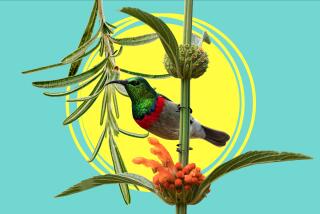Weather Is the Key to Good Gardenias
- Share via
Question: My gardenias never look as good as my friend’s. What is the secret to growing healthy gardenias?
C.D., Orange
Answer: Although fragrant gardenias are quite common in Southern California and can thrive here, they can be temperamental to grow if they are planted in the wrong spot.
To do well, they require heat during the day and cool nights. They should, therefore, be planted in a full sun location (except for in the hottest inland areas) that is warm during the day and cool at night.
Good locations are under the open sky and away from the house. Avoid planting close to house walls or in patio areas, because these locations tend to stay warmer at night.
When growing gardenias, you are somewhat at the mercy of the weather. In winter when soil temperatures drop below 62 degrees, they tend to experience chlorosis (yellow leaves with green veins).
Chlorosis occurs because the plant is unable to take up iron from the cold soil. If the condition is extreme, the leaves may all fall off.
You can fertilize with a ferrous sulfate or iron chelating agent to help remedy this problem, but the plant generally won’t be able to take up the iron until the weather warms in spring. Check with a California certified nursery professional regarding which iron products are best for gardenias.
Also keep in mind that fluctuations in nighttime temperatures--such as what we have experienced this winter--can affect flowering.
Although gardenias need daytime heat, if the nighttime temperatures are warm and exceed 60 to 62 degrees, the buds may form, but not develop. Then if we suddenly get a few cooler nights, the buds may drop off.
Gardenias prefer good drainage, regular watering and acidic soil.
Plant them high as you would azaleas to augment drainage and give them sufficient room so that they aren’t crowded by other plants or competing roots. They don’t tolerate going dry, so keep them evenly moist. Mulch well around the plant with an azalea/camellia mix, which will preserve moisture and acidify the soil.
Fertilize several times during the growing season beginning in spring with an acidic type fertilizer that contains an ammonium type of nitrogen such as ammonium sulfate, ammonium nitrate or urea. Also periodically fertilize with iron to prevent chlorosis.
After blooming, gardenias may be pruned to remove spent flowers and control straggly growth.
Gardenias benefit from morning dew or misting. If conditions aren’t moist enough, they are likely to be plagued by whiteflies, aphids and other sucking insects like thrips.
Gardenia Choices
There are numerous varieties of gardenias to choose from:
* ‘Mystery’ is probably the best-known variety. It has double white blooms on a 6- to 8-foot bush and blooms May through July. It becomes rangy without pruning.
* ‘August Beauty’ reaches 4 to 6 feet tall and has double blooms May through November.
* ‘First Love’ has larger blooms than ‘Mystery.’ Some feel its deeper green leaves are less likely to yellow.
* ‘Daisy’ has single blooms on a compact 3-foot-tall plant.
* ‘Golden Magic’ has full white flowers that age to a deep golden yellow on a 3-foot-tall plant. Blooms April to September.
* ‘Kimura Shikazaki’ (‘Four Seasons’) is a compact 2- to 3-foot-tall plant with a long bloom season from spring through fall.
* ‘Radicans’ grows just 6 to 12 inches tall with a 2- to 3-foot spread and 1-inch blooms in summer. It makes a good ground cover or container plant.
* ‘Veitchii’ is a compact 3- to 4-foot-tall gardenia with prolific blooms May through November.
Have a problem in your yard? University of California Cooperative Extension (UCCE) Master Gardeners are here to help. These trained and certified horticultural volunteers are dedicated to extending research-based, scientifically accurate information to the public about home horticulture and pest management. They are involved with a variety of outreach programs, including the UCCE Master Garden hotline, which provides answers to specific questions. You can reach the hotline at (714) 708-1646 or send e-mail to ucmastergardeners@yahoo.com. Calls and e-mail are picked up daily and are generally returned within two to three days.




